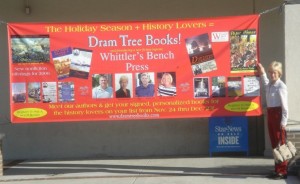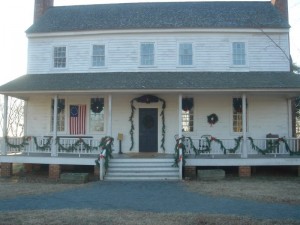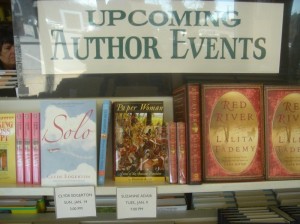On Sunday 3 December, staff writer Ben Steelman with the Wilmington Star-News reviewed Paper Woman. The headline reads “N.C. Author Spins a Swashbuckling Good Mystery Yarn,” and here’s the online link.
“…almost enough swashbuckling to wind Capt. Jack Sparrow,” he said and later compared Paper Woman to Jimmy Carter’s The Hornet’s Nest: “…as an adventure writer, [Adair] beats our former president plumb hollow.” Several authors have commented to me that Mr. Steelman is a tough critic, one who doesn’t give many good reviews. Grasshopper is very grateful. And still a bit dazed.

At Books-a-Million in Wilmington, Paper Woman was already selling well. After Steelman’s review was published, the novel sold even better and is on their top seller list. Exciting for the first fiction offering from a small press! If you’re in Wilmington, stop in and see us at Books-a-Million on Oleander Drive. My publisher will be there every day except Sunday through Christmas, and my family and I will be there the next two Saturdays in 18th-century clothing. (Look for the redcoat and his lady.) The Books-a-Million greeters in their festive Who-ville/Grinch hats make every visitor feel welcome — and as a bonus, they offer coupons for holiday discounts.

Last Saturday, I daytripped to the holiday open house at Alston House in Sanford, NC. Also called “The House in the Horseshoe” because it’s situated on land within a horseshoe-shaped bend of the Deep River, the house and grounds, originally owned by Philip Alston, were the scene of an intense, morning battle 29 July 1781 between Alston and his patriot friends and loyalist David Fanning and his men. The house was shot through with musket balls, and you can still see the holes on the exterior planks. Alston’s wife, Temperance, became so fearful for her children’s safety that she hid the kids in the fireplace. Then she initiated a ceasefire by exiting the house and signaling for parley. The first weekend of August each year, this battle is reenacted with great flair.
In contrast to the activity of battle, the holiday open house focuses on how a colonial-era home might have appeared for Yule: evergreen, holly, ivy, and soft candlelight the primary visual delights, with the scents of cinnamon, oranges, and molasses cakes in the air. Decades later, Prince Albert would elevate Christmas into the mighty celebration we’re familiar with today, but our colonial ancestors mostly acknowledged Yule with serenity and quiet, commemorating the shortest day and longest night with a festival of lights and seasonal foods and foliage, in much the same fashion as people had done for centuries before them.

Reenactors provided demos of musket fire and cannon fire and answered questions from visitors about their encampment. I tip my tricorn to those reenactors who spent the night; the temperature plummeted into the teens. Elizabeth Faison, the site coordinator, kindly allowed me to set up my signing table in the main room of the house, where the ambiance was cozy. She’d also seen to it that I received coverage in local papers, including The Pilot out of Southern Pines, and visitors who purchased Paper Woman informed me they’d read about me in the paper. That publicity, combined with the laminated copy of Ben Steelman’s review that I brought along, contributed to robust sales for me.
Just about every Revolutionary War event we attend, a spectator asks us, “What side are y’all on, the North or the South?” so we tell them, “Wrong war!” On Saturday, just down the street from my house, Mordecai Historical Park was hosting a Civil War reenactment. On our drive out to Alston House that morning, we’d navigated through a street congested with parked cars and spotted all the Confederate soldiers on the lawn lined up in gray wool uniforms, and the tents and campfires that look so much like our own campsites. When we came home late Saturday afternoon, the Civil War reenactors were still encamped at the park, and a dozen or so had clustered around a fire, trying to stay warm. We slowed the car to a crawl, leaned out the windows in obvious Revolutionary War clothing, and hollered, “God Save the King! God Save His Majesty!” They stared in shock at us several seconds until one of the guys finally hollered back, “Wrong war!” Exactly. We laughed the rest of the way home.

I’m delighted to announce that I’ll be appearing at Quail Ridge Books in Raleigh for a presentation and booksigning on Tuesday 9 January 2007. This will be my first author appearance in Raleigh. Quail Ridge Books is a wonderful independent bookstore.
Thanks to Ben Steelman, the gang at Books A Million, and Elizabeth Faison. Happy Holidays to everyone!
**********
Did you like what you read? Learn about downloads, discounts, and special offers from Relevant History authors and Suzanne Adair. Subscribe to Suzanne’s free newsletter.










